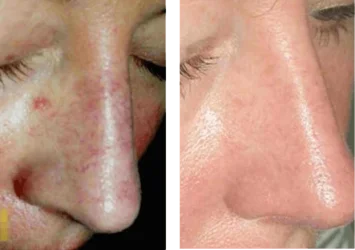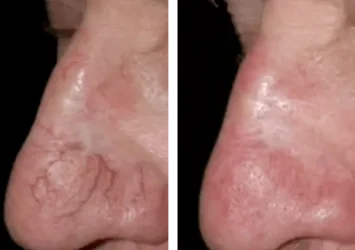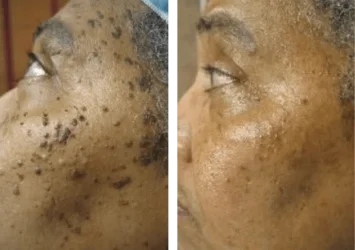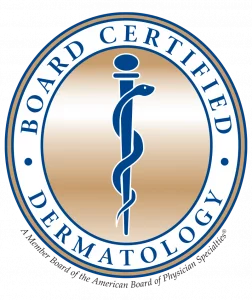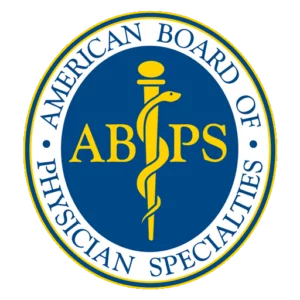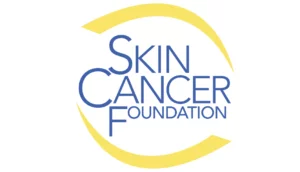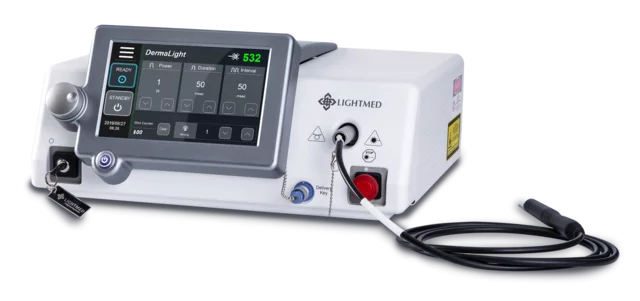
What is KTP Laser?
KTP laser is an FDA approved device for the treatment of common skin growths, and it is considered the best option for certain vascular and pigmented lesions. It is manufactured by the LightMed corporation in California and is widely used in Cosmetic Dermatology. The laser consists of a Solid State Diode Pumped 532nm Green Light Source with a flexible handpiece and a precise mechanism of delivery.
How does KTP laser work?
A high intensity wavelength of light is selectively absorbed by either hemoglobin (red pigment) or melanin (brown pigment) while sparing the surrounding skin. The undesired lesion is subsequently removed by the body’s natural immune response, while leaving the normal skin intact. This allows for precise removal of a lesion.
What types of problems does KTP treat?
- Broken blood vessels (telangiectasia) on the nose and cheeks
- Cherry angiomas
- Rosacea
- Venous lakes (blood vessel on the lower lip)
- Red acne scars and red surgical scars
- Acne (inflammatory type)
- Benign Pigmented Lesions
- Dermatosis Papulosis Nigra (DPN) – dark moles on the cheeks and around the eyes in people with skin of color
- Dark sunspots on the back of the hands
- Warts
What are the advantages of KTP treatment?
- Safe and Effective Treatment of Pigmented and Vascular Lesions
- Comfortable Treatments for Patient Usually with No Anesthesia Required
- Allows Precise Tissue Interaction with Minimal Collateral Tissue Affected
- High Energy Tissue Absorption and Penetration for Predictable Lesion Removal
- Flexible Fiber with Handpiece for Easy to Perform Cutaneous Treatments
- No Purpura (no bruising) for Greater Patient Satisfaction
Frequently Asked Questions (FAQ)
There is very little discomfort. It feels like somebody is touching a pin to your skin. Most people would estimate discomfort to be 2/10 on a pain scale. Use of ice/cooling is sufficient to keep people comfortable.
No. There is no need for anesthesia, and no need for topical anesthesia. We apply ice before and after the procedure which is more than sufficient for most people.
Avoid direct sun exposure one week before and one week after laser treatment. This means a hat and sunscreen (minimum 45 SPF) to cover treated areas. Do not plan on important social obligations for 3 to 4 days after laser treatment.
Immediately following the treatment, the areas treated will have a red flush/swelling which usually resolves within 24 hours depending on the intensity of the treatment and your skin type. Most vessels will disappear during the treatment but will often reappear when you get home. – This is normal as it takes
time for the body to reabsorb these blood vessels. Some larger vessels may be reduced in size. Areas treated for abnormal vessels may also form a linear scaly surface crust. These scabs will fall off by themselves a few days after treatment. Pigmented spots will turn darker during treatment and will remain visible until the lesion crusts and falls off naturally 5 to 15 days after the treatment.
Downtime is minimal.
No. You should avoid direct sun exposure for one week after the procedure. Otherwise, you may experience prolonged redness/swelling, prolonged hyperpigmentation, and inferior results.
We recommend three sessions for best results. Sometimes complete response is achieved in one or two treatments.
Four weeks.
No. This laser is considered cosmetic. The only exception is when lasers are used to treat warts.
No. This laser treats dark spots very well. However, light-colored sun freckles do not respond well to this type of laser. Diffuse photo damage is best treated either with BBL/IPL or chemical peels.

